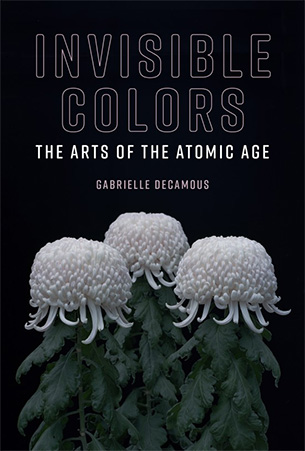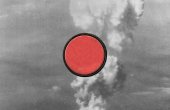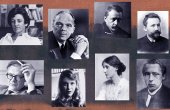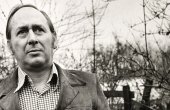The Dark Radiance of Atomic Bomb Literature

In the faint light of the three-mat dining room next to the kitchen, the unnamed narrator of Ōta Yōko’s autobiographical novella “Zanshū tenten” (translated as “Residues of Squalor,” or sometimes “Pockets of Ugliness,” 1954) peers at her relatives in the adjacent room, where they huddle, scrunched under an old pale green mosquito net. She notices the countless slugs beginning to crawl over the net and invade the room. She explains her reluctance to kill the slugs using her sister Teiko’s method: by removing the mollusks with chopsticks and dropping them in a can filled with salt water. She could not think of obliterating the slug infestation in such a way:
I looked in the can. They were half melting, but not completely melted. Thick and muddy, there was no sign of their having put up resistance to this sole primitive measure. After once eyeing this sight, I had begun to suffer from association. It was about human beings heaped up in a mound of death, half burnt but not completely melted, with no energy to show any sign of resistance. They were so alike.
In “Residues of Squalor” Ōta recounts her life as a survivor of the bombings: She chronicles her visits to the hospital, surveys the debris of her past love life in the ruins of the city that had started to rebuild itself, and shares haunting memories. The sight of the dying slugs reminds her of the uncountable deaths she had witnessed in Hiroshima; she thinks of the slugs as ghosts of the many soldiers who had died on the parade ground. Besides, to consider the “slugs as mere slugs” is not acceptable, she believes: “Heartless mollusks to me seemed personifications with hearts.” The association of slugs to dead soldiers is one of many moving details in “Residues of Squalor.” In “Hotaru” (“Fireflies,” 1953) Ōta similarly likens the souls of the soldiers to fireflies trapped between earth and heaven.

Ōta Yōko is known as the A-bomb writer, a label she herself endorsed, because she was the only hibakusha writer to have survived long enough to write an entire body of work on the bombings. (Hibakusha translates literally to “person affected by the bomb.”) The most well-known of her books is “Shikabane no machi” (“City of Corpses,” 1948), which directly recounts the horrors of the bombings. Other works include the novels “Ningen ranru” (“Human Tatters,” sometimes translated as “Human Rags,” 1951) and “Hanningen” (“Half Human,” 1954), the latter portraying radiation sickness, overmedication, and possible mental illness of a woman much like herself. Undoubtedly, the authenticity of her experience is what makes her accounts so memorable. Before the art of the atomic bomb opened to include other mediums, literature was its primary form of expression — so much so that Genbaku bungaku (A-bomb literature) became a genre of its own in Japan. The genre encompasses work ranging from the most important testimonials about the effects of radioactivity to equally powerful writings that immerse readers in symbolism and imagery, as with Ōta’s use of slugs and fireflies. In the 1970s, the Japanese A-bomb specialist Nagaoka Hiroyoshi, who singlehandedly uncovered the powerful radiance of the genre, brought some two decades worth of works to light in his seminal “Genbaku bungaku shi” (“History of A-bomb Literature,” 1973). According to Nagaoka, A-bomb literature evolved into four different phases that changed every five years or so. Each of the phases includes numerous writers and poets who were mainly hibakusha — the first period being the most important historically, with novelists such as Ōta Yōko and Hara Tamiki, as well as the poet Tōge Sankichi, being direct witnesses.
In “Hotaru” (“Fireflies”) Ōta likens the souls of the soldiers to fireflies trapped between earth and heaven.
Most scholars refer primarily to Hara when it comes to writing about A-bomb literature, or even to Kenzaburō Ōe who definitely played an important role in the genre, but less often to Ōta. This might be because Ōta produced nationalist novels during the war, and Japan had aligned itself with Nazi Germany. But, surprisingly, Nagai Takashi’s “Nagasaki no kane” (“The Bells of Nagasaki,” 1949) is more celebrated than any of Ōta’s novels. Although Nagai was a nationalist army physician, he took an antiwar stance after the bombings, as did Ōta. Perhaps Ōta’s gender explains such disregard for her prolific body of atomic age work.
In any case, A-bomb literature is densely populated with authors. The genre defies rigid artistic taxonomy since it embraces the many testimonies of nonprofessional writers, and yet these testimonies lack neither poetry nor moving literary style. The genre embraces contributors of all ages: there is the collection of poems Tōge wrote and edited with children, for instance, “Genshigumo no shita yori” (“From Beneath the Atomic Cloud,” 1952), and “Genbaku no Ko” (“A-bomb Children,” 1951), a collection of testimonies of hibakusha children. John Whittier Treat, an American scholar who has written substantially about A-bomb literature, praised a collection of testimonies titled “Genbaku taikenki” (“Personal Accounts of the Atomic Bomb,” 1965). He was particularly touched by the words of Mutsu Katsutoshi, a middle school teacher who wrote about the bomb this way:
As others, startled by the brilliant moment of light and the explosion like that of distant thunder, raised their heads to gaze their eyes of awe at the beauty of a strange mushroom cloud silently billowing high in the far blue skies, in another small corner of Hiroshima I was a traveler wandering somewhere betwixt the land of the living and the land of the dead.
Together with testimonials of Auschwitz, and of any human massacre, the genre of “documentary literature” or “docu-fiction” expanded after the war because, as Treat stated: “No one could have imagined anything as inhuman, a-human, as the German programs of genocide, or as total and efficient as a nuclear device.”
Scientists and physicians also wrote critical testimonies of their own. Nagai Takashi’s “The Bells of Nagasaki” became so prominent in Japanese culture that it inspired a long list of songs and films. Nagai’s work is pivotal in that he was a radiology expert who had worked with the army and who began writing compulsively after the bomb — even while bedridden. In his book, a particular moment stands out: Two of his students were discussing within the blasted hospital whether to save the contents of the X-ray room to later treat patients or help the wounded. Nagai decided in favor of helping the wounded. The powerful life-based metaphor is a sad reminder that Marie Curie’s efforts and hope for the future of radioactivity were in vain.
The 1945 diary of Hachiya Michihiko — a hospital director in Hiroshima — is also paradigmatic. As author and historian John W. Dower pointed out, although Hachiya’s bomb-related injuries left him with about 150 facial and body scars, he worked in his ruined, overcrowded, and foul-smelling hospital (the place reeked from the cremation of the bodies) “with composure [and] compassion.” Nagai’s and Hachiya’s writings, together with nurse Fumitsuki Junko’s literary account of the death of Ōta Yōko, as well as Ōta’s discussion of Japanese scientific reports of the bomb and radioactivity in “City of Corpses,” demonstrate that the art/science compound is unarguably present in postwar Japan too.
With a death toll of at least 200,000 people in Hiroshima and Nagasaki, it is surprising that even today the genre is still relatively unknown.
But most surprisingly, despite the many works that were anthologized in the 1980s in two editions amounting to dozens of volumes in Japan, Japanese A-bomb literature remains largely unknown to the West and only partially translated. The hibakusha poet Kurihara Sadako accurately pointed out how the literature of the Holocaust is widespread compared to A-bomb literature. Ōta, Hara, and Tōge were partially referred to or quoted in at least two early Western works, one that took a psychoanalytic approach to the literature (Robert Jay Lifton’s “Death in Life: Survivors of Hiroshima”) and the other by a journalist more focused on the making of the bomb than its aftermath. They were finally acknowledged by literary circles in the 1990s due to John Whittier Treat’s brilliant analyses. Although the interest in A-bomb works is cyclical, commentary on the bomb’s consequences for the mostly civilian population receives less attention than the military power and use of the bomb, as Dower has noted. But with a death toll of at least 200,000 people in both cities, it is surprising that even today the genre is still relatively unknown, even sometimes in Japan.
This is precisely where the power imbalance of the atomic age resides. The invisibility of radioactivity is not the challenge. Instead, the challenge comes from the intricate politics that have made invisible radioactivity’s calamitous consequences by obliterating the voice of the victims. This is true not only of Japanese literature but also of painting, sculpture, photography, and poetry. As a result, there are clear differences in the ways in which the bombings were represented in Japan and in the West. Investigating these differences, as well as the reasons for these disparities (but also their similarities) is an absolute necessity — even decades later — especially because A-bomb literature kept its “dark radiance,” as philosopher Maurice Blanchot has said of the literature of the Holocaust.
The Japanese philosopher Kazashi Nobuo wrote a poetic account revisiting the significance of the Hiroshima A-bomb dome, the monument that is left standing in the heart of the city. Even during the reconstruction with “super modern building” lining up around it, and sometimes gloomily engulfed by the architectural fashion of the moment, the A-bomb dome still stands, floating in the center, from dawn to dusk, in the illuminations of the city.
In “Tetsugaku no 21 seiki: Hiroshima kara no daiippo” (“Philosophy of the 21st Century, First Steps from Hiroshima,” 1999), Kazashi explains that this “A-bomb dome city” still holds a specific power. He alludes to a theme in Thomas Mann’s “Magic Mountain” (1924) by saying that one gets used to saying that one can never get used to things. The contrasting figure of the A-bomb landscape, the origin of the nuclear age, “so to speak, has a power to re-ask [questions] about the meaning of the human civilization, about life itself and its foundation.”
Hiroshima’s A-bomb literature also stands as a glowing nuclear archive — a metaphoric monument as real as the dome in the city — and a significant part of that archive includes Hiroshima testimonials. Unfortunately as Nagaoka underscores, no equivalent of the A-bomb dome exists in Nagasaki; perhaps because of that, Nagasaki literature is less extensive and attracts less attention. Yet Nagasaki deserves more of a spotlight since the city was bombed after Hiroshima not to win the war — but to make a statement. It was a postwar exercise of military capacity and power, as Treat stated in “Writing Ground Zero.”
Although it is commonly thought that the artistic representation of something as inconceivable and incomprehensible as the atomic bombings is impossible, uncountable works exist whose dark radiance shows that Hiroshima and Nagasaki are not the “unthinkable.” The more we expose ourselves to the prose of the victims, the more visibility we give them.
Gabrielle Decamous is Associate Professor in the Faculty of Languages and Cultures at Kyushu University in Fukuoka, Japan and author of “Invisible Colors: The Arts of the Atomic Age,” from which this article is excerpted.



